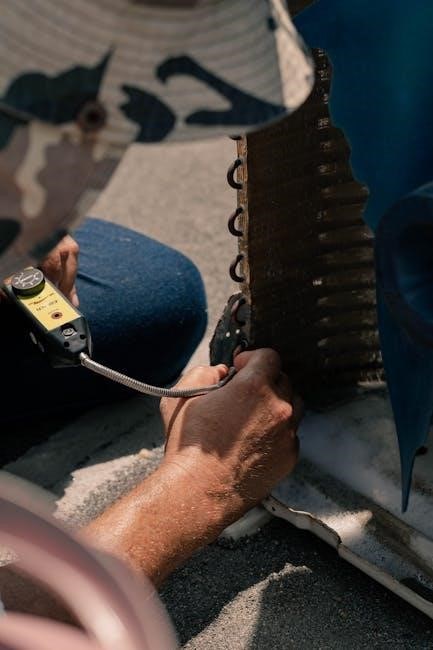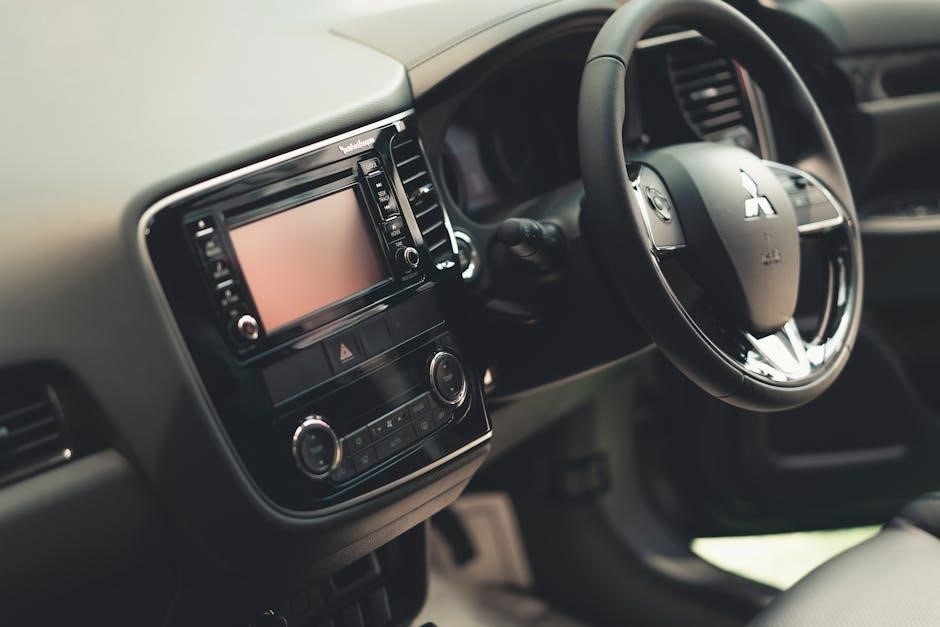mitsubishi air conditioner troubleshooting guide
Troubleshooting your Mitsubishi air conditioner is essential for maintaining optimal performance and addressing common issues like airflow problems, error codes, or cooling inefficiencies. This guide provides practical solutions to restore comfort and efficiency.
Importance of Regular Maintenance
Regular maintenance is crucial for ensuring your Mitsubishi air conditioner operates efficiently and effectively. Neglecting routine checks can lead to reduced performance, increased energy bills, and even premature system failure. By cleaning air filters, inspecting condenser coils, and ensuring proper refrigerant levels, you can prevent common issues like airflow problems and cooling inefficiencies. Maintenance also helps identify potential faults early, avoiding costly repairs. A well-maintained system not only enhances comfort but also extends the lifespan of your air conditioner. Schedule professional inspections annually to keep your unit running smoothly and reliably. Remember, consistent upkeep is key to maximizing your Mitsubishi air conditioner’s performance and longevity.

Preparation for Troubleshooting
Before troubleshooting, ensure you have the necessary tools and refer to the user manual. Check circuit breakers, verify settings, and understand error codes. Resetting the unit or consulting a technician may be required for complex issues.
Essential Tools and Equipment Needed
When preparing to troubleshoot your Mitsubishi air conditioner, gather essential tools to diagnose and resolve issues effectively. A multimeter is crucial for checking electrical connections and voltage levels. Pressure gauges are necessary for measuring refrigerant pressure, while leak detectors help identify refrigerant leaks. A screwdriver set and wrenches are handy for accessing internal components. Ensure you have a pair of gloves and safety goggles for protection. Additionally, a remote controller or thermostat may be needed to test operation. Referencing the user manual is vital for understanding specific error codes and procedures. For advanced issues, specialized tools like a vacuum pump or manifold set may be required. Always ensure tools are in good condition to avoid further damage. By having these tools ready, you can efficiently address common problems like airflow issues, cooling inefficiencies, or error codes, ensuring your Mitsubishi air conditioner operates smoothly.
Safety Precautions Before Starting
Before troubleshooting your Mitsubishi air conditioner, ensure a safe working environment to avoid accidents or further damage. Always turn off the power supply to the unit at the circuit breaker or electrical panel. Verify the power is off using a multimeter to prevent electrical shocks. Wear protective gear, including gloves and safety goggles, to safeguard against sharp edges or debris. If the unit is mounted at a height, use a sturdy ladder and ensure proper footing. Never attempt to troubleshoot while the unit is operational or under pressure. If refrigerant handling is required, follow proper safety protocols to avoid exposure. Keep the area well-ventilated to prevent the accumulation of harmful gases. Avoid using unauthorized tools or methods, as they may cause irreversible damage. If you are unsure about any procedure, consult a professional technician. Safety should always be your top priority when working with electrical and refrigeration systems.
Understanding the User Manual
Understanding the user manual is crucial for effective troubleshooting of your Mitsubishi air conditioner. The manual provides detailed information about the unit’s operation, maintenance, and diagnostic procedures. It outlines error codes, symptoms, and solutions, helping you identify and address issues efficiently. Familiarize yourself with sections like installation, wiring, and safety precautions to ensure safe and proper troubleshooting. The manual also includes diagrams and flowcharts to guide you through complex procedures. Always refer to the manual before attempting any repairs, as it contains model-specific instructions that may vary from general troubleshooting tips. Pay special attention to the troubleshooting section, which lists common problems, their causes, and step-by-step solutions. By understanding the manual, you can diagnose and resolve issues confidently, avoiding unnecessary damage or costly repairs. Keep the manual in an accessible location for quick reference whenever a problem arises.

Common Issues and Their Solutions
Common Mitsubishi air conditioner issues include airflow problems, error codes, cooling inefficiencies, water leaks, and noisy operation. Solutions involve checking filters, inspecting for blockages, and addressing refrigerant leaks or sensor malfunctions promptly.

Airflow Problems and Solutions
Airflow issues are common in Mitsubishi air conditioners, often caused by dirty filters, blocked vents, or improper unit installation. To resolve these, start by cleaning or replacing the air filters to ensure proper airflow. Check for any obstructions in the vents or ducts, such as dust buildup or foreign objects, and remove them. If the unit is not installed correctly, consult a professional to adjust its positioning. Additionally, ensure that all doors and windows are sealed to maintain consistent airflow. If the problem persists, inspect the fan motor for damage or malfunction. Regular maintenance, such as cleaning the condenser coils, can also improve airflow efficiency. Addressing these issues promptly will help restore optimal performance and prevent further complications. Always refer to the user manual for specific guidance on troubleshooting airflow-related problems in your Mitsubishi air conditioner.

Cooling or Heating Inefficiencies
Cooling or heating inefficiencies in Mitsubishi air conditioners can result from low refrigerant levels, compressor issues, or sensor malfunctions. If the air feels warm or the unit struggles to heat, check for refrigerant leaks, as this is a common cause. Inspect the condenser coils for dirt or blockages, as poor airflow can reduce efficiency. Ensure the thermostat is set correctly and functioning properly. If the issue persists, examine the compressor for potential damage or wear. Sensors, such as the thermistor or pressure sensors, may also malfunction, disrupting temperature regulation. In such cases, professional diagnosis is recommended. Regular maintenance, including cleaning the condenser coils and checking refrigerant levels, can prevent these inefficiencies. Addressing these problems promptly will restore your Mitsubishi air conditioner’s performance and ensure consistent cooling or heating. Always consult the user manual or a certified technician for complex repairs to avoid further damage.
Water Leaks from the Unit
Water leaks from a Mitsubishi air conditioner are often caused by issues with the condensate drainage system or refrigerant leaks. If water is dripping from the unit, check the drain pan and condensate drain line for blockages or damage. A clogged drain can cause water to accumulate and overflow. Ensure the unit is installed correctly, as improper installation can lead to drainage problems. Additionally, frozen evaporator coils due to low refrigerant levels or poor airflow can cause water to leak when the ice melts. Inspect the drain hose for kinks or obstructions and clean it if necessary. If the issue persists, it may indicate a refrigerant leak, which requires professional attention. Regular maintenance, such as checking the drain system and ensuring proper refrigerant levels, can prevent water leaks. Addressing these issues promptly will help avoid damage to the unit or surrounding areas;
Noisy Operation of the Air Conditioner
Noisy operation in a Mitsubishi air conditioner can be caused by various factors, including loose screws, debris in the fan, or malfunctioning internal components. If the unit produces unusual sounds like rattling, buzzing, or grinding, it is essential to identify the source. Start by turning off the air conditioner and inspecting the outdoor and indoor units for loose parts or obstructions. Clean the fan blades and ensure they are free from debris. If the noise persists, it may indicate a problem with the motor or compressor. In such cases, consulting the user manual or contacting a professional is recommended. Additionally, error codes or blinking lights on the unit can provide clues about the issue. Regular maintenance, such as tightening screws and cleaning filters, can help prevent noisy operation. Addressing the problem early can avoid further damage and ensure smooth, quiet performance.
Error Codes and Their Meanings
Mitsubishi air conditioners use error codes like U6 and U7 to indicate issues such as compressor problems or abnormal superheat. Blinking lights on the unit help diagnose these faults, aiding effective troubleshooting.
Common Mitsubishi Air Conditioner Error Codes
Mitsubishi air conditioners often display error codes to indicate specific issues. One common code is U6, which signals a compressor overcurrent interruption or an abnormality in the power module. Another frequent code is U7, related to superheat abnormalities due to refrigerant issues. Additionally, U4 may appear, indicating a communication error between the indoor and outdoor units; Blinking lights on the unit can also signal problems, such as a green light blinking to indicate refrigerant leakage. Understanding these codes is crucial for effective troubleshooting. For instance, if the compressor is faulty, it may require professional repair. Always refer to the user manual for specific code meanings, as they can vary slightly by model. Addressing these codes promptly ensures optimal performance and prevents further damage. If unsure, consulting a certified technician is recommended to resolve complex issues efficiently.
How to Interpret Blinking Lights
Mitsubishi air conditioners use blinking lights to indicate specific issues, helping users identify problems quickly. For example, a green light blinking may signal refrigerant leakage, while a red light could indicate a communication error between the indoor and outdoor units. To interpret these lights, count the number of blinks between pauses and refer to the user manual for code meanings. Some models display error codes through light patterns, such as U6 or U7, which relate to compressor or superheat issues. If the indicator lamp flashes continuously, it may signal an internal malfunction. Always consult the manual for accurate diagnosis, as codes vary by model. If unsure, contacting a certified technician is recommended to resolve complex issues efficiently and ensure optimal performance. Blinking lights are a valuable diagnostic tool, guiding users to address problems before they escalate. Regular checks can prevent unexpected breakdowns and maintain system efficiency.
Resetting the Air Conditioner
Resetting your Mitsubishi air conditioner can often resolve minor issues like error codes or unexpected shutdowns. To reset, locate the reset button, usually found on the indoor unit or remote control. Press and hold the button for 10-15 seconds until the unit powers off. Wait a few minutes, then turn it back on. If your model doesn’t have a reset button, try power cycling: switch off the AC at the breaker, wait 30 seconds, and restart it. This process resets the system and clears temporary glitches. Always refer to the user manual for model-specific instructions, as some units may have unique reset procedures. If the issue persists after resetting, consult a professional to address underlying problems. Resetting is a simple yet effective first step in troubleshooting, helping restore functionality without advanced tools or expertise.

Advanced Troubleshooting Techniques
Advanced troubleshooting involves diagnosing electrical issues, identifying refrigerant leaks, and checking sensor malfunctions. These techniques require specialized tools and expertise to ensure accurate diagnoses and effective repairs for optimal performance.
Diagnosing Electrical Issues
Diagnosing electrical issues in your Mitsubishi air conditioner involves checking for tripped circuit breakers, faulty wiring, or power module abnormalities. Start by ensuring the unit is turned off and unplugging it for safety. Use a multimeter to test voltage levels at the circuit breaker and connections. If the breaker trips repeatedly, it may indicate an overcurrent situation. Inspect wiring for signs of damage or wear, as frayed cords or loose connections can disrupt power supply. Additionally, check the power module for any signs of burnout or malfunction, which can cause error codes like U6. Refer to the user manual for specific error code interpretations. If you identify a blown fuse or tripped breaker, reset or replace it and test the unit. If issues persist, consult a professional technician to avoid further complications.
Identifying Refrigerant Leaks

Refrigerant leaks are a common issue in Mitsubishi air conditioners, often indicated by reduced cooling performance or hissing sounds. To identify leaks, start by turning off the unit and inspecting the refrigerant lines for visible damage or corrosion. Use a leak detection kit or electronic detector to pinpoint the source. If the system’s green light blinks, it may signal a refrigerant leak. Check for frost buildup on the evaporator coil, as this can also indicate low refrigerant levels. If a leak is confirmed, turn off the unit immediately to prevent further damage. Refrigerant handling requires professional expertise, so consult a certified technician to repair the leak and recharge the system. Addressing this issue promptly is crucial to restore efficiency and prevent costly repairs.

Checking for Sensor Malfunctions
Sensor malfunctions can disrupt your Mitsubishi air conditioner’s performance, leading to issues like inconsistent temperatures or erratic operation. To identify sensor problems, start by checking the temperature sensors located near the evaporator and condenser coils. Ensure they are clean and free from blockages. If the sensors are dirty, gently clean them with a soft cloth. Next, inspect the room sensor, which regulates airflow based on ambient temperature. If the sensor is faulty, the unit may not adjust properly. Consult the user manual or error codes, as some models display specific codes for sensor issues, such as U6 or U7. Use a multimeter to test sensor continuity if you suspect a wiring issue. If a sensor is damaged, replace it with an OEM part. If unsure, contact a certified technician to diagnose and repair the problem. Addressing sensor malfunctions promptly ensures reliable operation and energy efficiency.
Maintenance Tips for Optimal Performance
Regularly clean the air filter and inspect condenser coils to ensure efficient airflow and cooling. Schedule professional maintenance annually to check refrigerant levels and electrical connections, ensuring your Mitsubishi AC runs smoothly year-round.
Cleaning the Air Filter
Cleaning the air filter is a crucial maintenance step for your Mitsubishi air conditioner. A dirty filter can reduce airflow, lower efficiency, and increase energy bills. To clean the filter, turn off the power and remove it from the unit. Gently vacuum or wash it with mild soap and water. Allow it to dry completely before reinstalling. Replace the filter if it’s damaged or excessively dirty. Regular cleaning ensures better air quality and system performance. Clean the filter every 1-2 months, or more often in dusty environments. This simple task prevents major issues like cooling inefficiencies or system overwork. Always refer to your user manual for specific instructions tailored to your model. A clean filter is the first line of defense for optimal operation and long-term durability of your Mitsubishi air conditioner.

Inspecting and Cleaning the Condenser Coils
Inspecting and cleaning the condenser coils is vital for maintaining your Mitsubishi air conditioner’s efficiency. Dirty coils can reduce heat exchange, leading to poor performance and higher energy bills. Start by turning off the power to the unit for safety. Remove the protective grille and gently brush away dirt, leaves, or debris using a soft-bristle brush or vacuum cleaner. For stubborn dirt, use a garden hose with low pressure to rinse the coils. Avoid using harsh chemicals or abrasive materials that could damage the coils. Regularly cleaning the condenser coils ensures proper airflow and prevents overheating. If you notice bent fins, straighten them carefully with a fin comb to maintain optimal performance. Cleaning the coils every 2-3 months, or more often in dusty areas, is recommended. This simple maintenance task can significantly improve your air conditioner’s efficiency and extend its lifespan. Always refer to your user manual for specific guidance on your model.
Scheduling Professional Maintenance
Scheduling professional maintenance for your Mitsubishi air conditioner is crucial for ensuring optimal performance and preventing major issues. While DIY troubleshooting can address minor problems, a certified technician can identify and fix complex issues like refrigerant leaks, electrical faults, or sensor malfunctions. Regular professional checks help maintain energy efficiency, reduce operational costs, and extend the lifespan of your unit. During maintenance, technicians will inspect and clean internal components, check refrigerant levels, and ensure proper electrical connections. They can also diagnose issues early, preventing unexpected breakdowns. It’s recommended to schedule professional maintenance at least once a year, preferably before the start of the cooling or heating season. This ensures your Mitsubishi air conditioner operates smoothly and reliably. Additionally, professional maintenance can validate your warranty and provide peace of mind. Always choose a licensed and experienced technician familiar with Mitsubishi systems for the best results.

Mastering Mitsubishi air conditioner troubleshooting ensures efficient operation, extends lifespan, and enhances comfort. Regular checks, professional maintenance, and addressing issues early are key to optimal performance and reliability.
Final Thoughts on Effective Troubleshooting
Effective troubleshooting of your Mitsubishi air conditioner requires a proactive approach, combining regular maintenance with a thorough understanding of common issues. By addressing problems early, such as airflow restrictions or error codes, you can prevent minor issues from escalating into costly repairs. Always refer to the user manual for specific guidance, as it provides valuable insights into error codes and operational norms. For complex problems like refrigerant leaks or sensor malfunctions, consulting a professional is advisable to ensure safety and efficiency. Remember, consistent upkeep, such as cleaning filters and inspecting coils, plays a crucial role in maintaining optimal performance. Troubleshooting not only saves time and money but also extends the lifespan of your unit, ensuring consistent comfort and reliability. By following these tips, you can diagnose and resolve issues confidently, keeping your Mitsubishi air conditioner running smoothly for years to come.
